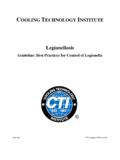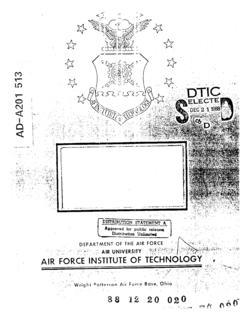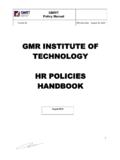Transcription of Technology Stage-Gate™: A Structured Process for Managing ...
1 Technology Stage-Gate :A Structured Process forManaging high -Risk NewTechnology ProjectsGreg M. Ajamian and Peter A. KoenTraditional Stage-Gate (SG) (Cooper 1993) or PACE processes (McGrath andAkiyama 1996) assume that there is little uncertainty associated with the technologiesto be utilized. However, the inability to manage high -risk technologies as part ofproduct development is frequently the cause of canceled or significantly delayed newproduct development projects. Unlike product development, the ultimate outcomes oftechnology development efforts are unpredictable. Prematurely introducing atechnology into the product development Process when there is high uncertainty thatthe Technology will ever meet the desired specifications often leads to project delays,project uncertainty, and project have found that a different management Process , the Technology Stage-Gate (TechSG) Process , is needed to manage Technology development efforts whenthere is high uncertainty and risk.
2 TechSG, initially described by Eldred and Shapiro(1996) and Eldred and McGrath (1997), brings a Structured methodology formanaging new Technology development without thwarting the creativity needed inthis early stage of product overall objective of this chapter is to provide the reader with more insightinto the Process and to describe the tools and methodologies that make up theTechSG Process . The Process is specifically intended to manage high -risk technologydevelopment projects when there is uncertainty and risk that the Technology discoverymay never occur and therefore the ultimate desired product characteristics mightnever be understand the difference between TechSG and traditional SG processes andthe need for the TechSG Process , consider the following extreme example.
3 Imaginethat due to unanticipated changes in regulations a business has decided that it willneed a new product in its line that would best be described as "water withouthydrogen." If the business immediately began a traditional SG Process , it would verylikely get bogged down in the product development stage, since no one had everproduced such a molecule. The product development teamwould be trying to complete the product design while their scientists were still tryingto discover how to make the molecule in the laboratory. By using a TechSG processto focus on the Technology development issues (with a long-term view towardbusiness strategy, plans, and needs), the business can manage the technologydevelopment effort separately. The effort would continue until it is feasible to startproduct development or it becomes evident that the risks are too high or the rewardstoo low to pursue the Technology .
4 In this example, the TechSG Process would beused to manage the Technology development effort until the risks have beensubstantially reduced by demonstrating the ability to at least produce such amolecule in the overall innovation Process may be divided into three areas: the fuzzy frontend (FFE), new product development (NPD), and commercialization, as indicated inFigure 11-1. Many companies utilize traditional SG systems to manage the NPDprocess. For most companies, even for a totally new offering, product developmentis essentially a known, predictable, and repeatable Process . From 70 to 85 percent ofthe Process is the same from product to product, , planning, laboratory trials,preliminary design, internal and external testing, manufacturing scale-up, supporttraining, market launch planning, and commercialization (Cooper 1993).
5 Creativityis less of an issue in the actual development and commercialization of the leaders need good project management skills and decision makers need toconcentrate on the overall costs and benefits to the business. Traditional SGprocesses have brought dramatic reductions in product development cycle time inmany companies by bringing structure and an overall business Process to the NPDprocess. However, a frequent complaint about and limitation of the traditional SGprocess is that product development begins when the ultimate outcome of thetechnology development efforts still contains significant uncertainty and risk. Thishas often been a source of frustration, causing significant delays and wastedFIGURE 11 -f. Overall innovation Process may be divided into three parts: the fuzzy frontend, new product development, and SC processes are utilized to manage protects in new product is used to manage high -risk projects within and at the transition between thefuzzy front end and new product ProductDevelopmentFuzzyFront EndTraditional Stage Gate ProcessTechnology Stage Gate Processeffort as the advantages and limitations of the new Technology are determined.
6 Thetechnical uncertainty and continuing missed project deadlines associated withintroducing a yet-to-be-completed Technology discovery often results in lies within and between FFE and the traditional SG Process . The FFErepresents the initial part of product development, from idea generation todevelopment of a concept that includes primary features and customer benefitscombined with a broad understanding of the Technology needed. The traditional SGprocess typically begins with a well-defined concept, although many companiesinclude the FFE in the initial part of the traditional SG Process . Due to highuncertainty especially in high -risk projects we prefer not to include the initial partof the FFE in the traditional SG Process .
7 Further, we recommend that high -riskprojects do not enter the traditional SG Process if the project contains technologieswhere the ultimate outcome of the Technology development effort has elements ofboth high uncertainty and high risk. Conceptually, the traditional SG portion of theproduct development Process will not start until the TechSG Process is completed andthe Technology development risks have been substantially reduced. In actuality, manyprojects start the traditional SG Process in the later stages of the TechSG Process ,when significant risk has been reduced, in order to get to the marketplace Technology development is by definition new, different, and is difficult to capture and leverage past experience for future efforts, making cycletimes difficult to estimate.
8 One cannot "schedule" Technology discovery. The range ofpossible experiments and their outcomes is almost limitless. Detailed overall projectplanning is therefore impractical. Too much structure or repetition of past work canseverely inhibit creativity. It is often difficult to determine when the new technologyis ready to transition to product development. This can be a very subjective decision,arrived at through informed discussions. Much more than in traditional SG, duringnew Technology development, project leaders need the ability to manage uncertaintyand do "good science" while focusing on project goals. (Examples of project goals fora next-generation copier [see Table 11-3] could be higher productivity, environment-friendliness, and lower operating cost.) Decision makers need to be able to balancerisk and probability versus business needs and potential overall purpose of the TechSG Process is to bring both scientific andbusiness rigor into the Technology discovery Process , to better select and allocateresources to high -risk projects, and to reduce Technology development times.
9 Thehallmark of a well-functioning TechSG is a project that is being executed using soundscientific principles and is properly resourced. Traditional SG projects also need to beproperly resourced, but the importance of doing good science is less of an issue sincethe Technology is already known. Initial reluctance to implement a TechSG Process isrelated to the presumption that the added structure will inhibit creativity. In fact, wehave found just the opposite. Technology development teams embrace the TechSGsince it brings a scientific rigor often missing in many of their projectsTraditional Stage-Gate Technology Stage-Gate FIGURE 11-2 In traditional SG, shown on the left, the gates are transparent. The productdevelopment team can "see" all the deliverables at the gates. In contrast, in TechSG, shownon the right, the gates are opaque.
10 The Technology development team can only "see" to thenext gate and understands that the deliverable may change as the Technology is Eldred and Shapiro 1996. Reprinted with to inadequate manpower allocation and financial resources, lack of the correctscientific expertise, and lack of peer differences between the traditional SG Process and TechSG may beconceptualized in Figure 11-2. In the traditional SG Process the gates representedby walls are transparent, since most of product development is predictable. Thegates can be identified, clearly defined, and planned for, and their outcomes areknown right from the beginning of the project. The product development team can"see" through the walls to the end of the project and can clearly envision the endresults. Like the traditional SG Process , the TechSG Process consists of a series ofgates or reviews.




